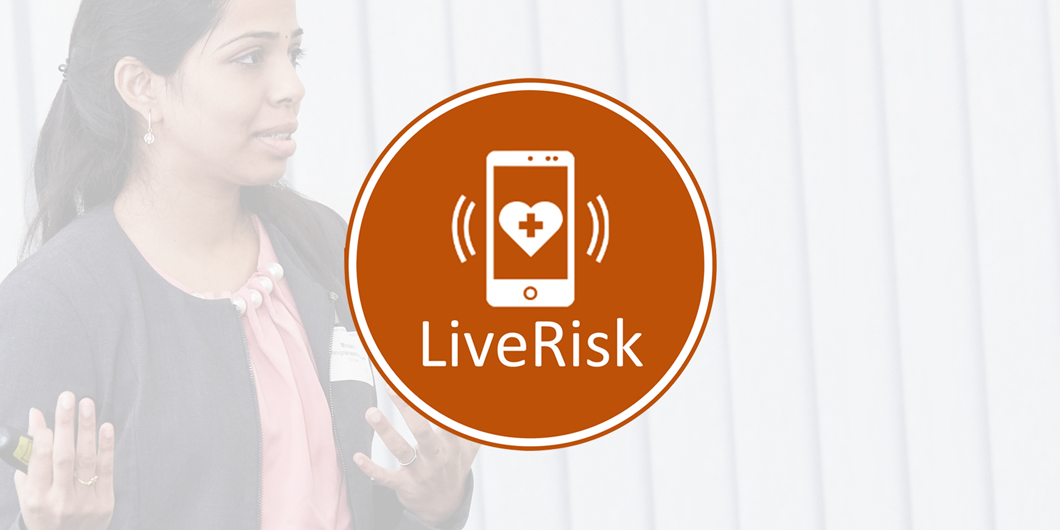Team LiveRisk, what are you up to with your idea?
The aorta is the main human artery that carries blood from the heart to the different parts of the body. The region of the aorta below the level of the kidneys is called the abdominal aorta. When the abdominal aorta bulges and expands to more than 50% of its original diameter, it is described as an abdominal aortic aneurysm (AAA) which has the potential to eventually rupture and lead to death. In Switzerland alone, around 500,000 people suffer from AAAs.
LiveRisk is developing a novel real-time monitoring platform for evaluating AAA rupture risk. With this smartphone app, patients can track the growth of their AAA at home. This will be especially helpful to patients with small AAAs who are kept under surveillance and are advised to follow-up with the doctor according to an individual predefined schedule (usually 6 months to 1 year). If they have a high rupture risk, the caring physician can bring arguments for a repair. A patient with a low risk profile can confidently choose to continue with surveillance with much less or without anxiety. Through LiveRisk, health costs, mortality rates, and emergency operations can be reduced.
So, you want to develop an innovative self-monitoring application for AAA’s. How did you come up with the idea to set up a start-up in this area?
This idea is a perfect example of a strong cross-disciplinary collaboration. Our team consists of a radiologist, a physicist turned innovator, and an engineer. Our common interests merged in studying the development and rupture of AAAs, while introducing a translational perspective to all physicians e.g. a vascular specialist. Research has been done in this field for decades, but it has not been able to reach the clinicians, let alone the patients. We could clearly see the need for a simple AAA monitoring system that the patients would like to use at home and would help the caring physician network. This was the perfect opportunity to bring digital health into the picture, and when combined with AAA research, LiveRisk was born.
For such an idea you definitely need a lot of medical and computer science know-how. How is your team composed, what are your professional backgrounds? How do you know each other?
Our team is composed of three specialists in their subsequent fields: Prof. Dr. Hendrik von Tengg-Kobligk, who is the Vice chair of the University Institute for Diagnostic, Interventional and Pediatric Radiology at Inselspital. His expertise in imaging and finding image-based markers will be crucial to the novel MRI protocol which will be used to derive the technology behind LiveRisk. Dr. Raniero Pittini, who is the Head of Research at MedTech in Switzerland Innovation Park Biel/Bienne (SIPBB). His experience in working with medical systems, digital health applications, sensor-based technologies and Bluetooth-based transfers will be invaluable to development of the LiveRisk platform. Last but not least, Dr. Mirunalini Thirugnanasambandam, who is a postdoctoral fellow at University of Bern, Inselspital and SIPBB. She is a biomedical engineer with 6 years of experience in image-based biomechanical modeling of AAAs. Her role is to use the image-based results from the clinic and transform it into a patient-usable index which can be output by LiveRisk.
Dr. von Tengg and Dr. Pittini have known each other through their earlier collaborations. Dr. Thirugnanasambandam was hired as their joint postdoctoral fellow to pursue research in imaging-based translational cardiovascular research. In addition, we also have the support from our research and clinical collaborators at Inselspital and ARTORG Center for Biomedical Engineering Research, who are excited about the potential of LiveRisk.
Your project is located in the LifeScience / MedTech area, where the path to a successful product launch can be very lengthy. What is your incentive to go this long way? What is your vision behind your idea?
We are well aware that LiveRisk is in the first stage of the product life cycle and we have a long way to go. But we are confident that the effort will be worth it, since the vision of LiveRisk is to provide better research-based clinical management and better lifestyle for patients who are already suffering from a disease like AAA which has a rupture mortality rate of 90% outside the hospital.
You had your first pitch in front of the jury on January 25 and got a GO. This entitled you to participate in the coachings & workshops. Did they help you in developing your business plan? And, what are you still hoping for from the BBCW?
The coaching and workshops that were offered through BBCW have been extremely helpful in developing our business plan. They have also been a source of reality checks which make us clearly understand the pathway from conceiving an idea to launching the product in the market. We have had the incredible opportunity to interact with experts from vastly different fields and network with fellow entrepreneurs who are in the same stage as ours. In the end, our hope from BBCW is to see if it is possible to make our idea into a real product.

